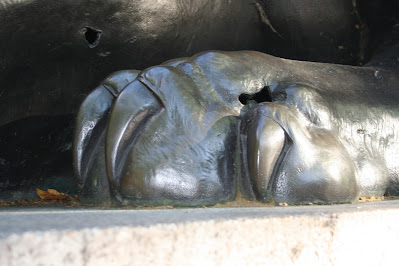After centuries of peace on the banks of the Nile River, the obelisk known as Cleopatra's Needle was moved to the banks of another river – the Thames, in London.
And here, on the night of 4 September 1917, the German air force launched a bombing raid, and the obelisk base and one of the two sphinxes was hit by shrapnel.
And here, on the night of 4 September 1917, the German air force launched a bombing raid, and the obelisk base and one of the two sphinxes was hit by shrapnel.
 |
| Zeppelin raids on London in WWI |
Enter Kaiser Wilhelm II
During the first World War French planes bombed German towns, and Kaiser Wilhelm II agreed that the German air force should retaliate, and allowed Zeppelins to be used in bombing London for the first time on May 31, 1915.
Enter the Count
The first large-scale builder of airships, Count Ferdinand von Zeppelin (1838 – 1917), had served a stint in the Union army during the U.S. Civil War, and conducted balloon trials there as a military oberserver.
He spent his life building the rigid dirigibles, with the first successful flight of his airship in 1900; within eight years Zeppelins were delivering mail and passengers over Germany.
He spent his life building the rigid dirigibles, with the first successful flight of his airship in 1900; within eight years Zeppelins were delivering mail and passengers over Germany.
Enter the German armed forces
In 1909 the German army used the first Zeppelin; during the first World War they used 115 Zeppelins for various missions, including bombing raids – the Zeppelins bombed England at the rate of about two per month.
Of the 115 Zeppelins, 53 were destroyed and another 24 so damaged they could not be used again.
With a little bit of help from the cows
The airships used an outer envelope and several separate gasbags inside, containing helium; about 200,000 sheets made from the intestines of cows were used to make the the goldbeater's skin of the gasbags of each airship.
The Zeppelins flew so high above London that the British fighter planes could not reach them, and when they did, their ammunition did not damage the airships – it was only in mid-1916 that the British planes were successful in using the new explosive bullets to punch holes into the outer skin of the Zeppelins and the incendiary bullets to set them on fire.
Only about ten percent of the bombs dropped from the Zeppelins hit their targets because bomb aiming was inaccurate, but the psychological impact was significant.
 |
| Gotha bomber - World War One |
And now for the Gothas
When Zeppelin losses mounted, the German forces switched to airplanes, including the Gotha biplane aircraft, which flew at night and sometimes reached 20,000 feet, beyond reach of the British fighter planes.
Landing a Gotha was tough – one estimate attributes 70% of Gotha losses to bad landings.
The first flight of a Gotha took place only 13 years after the Orville Brothers first airplane flight in the Kitty Hawk. Gothas made 22 raids on England, and lost 61 aircraft.
The Harvest Moon raids
Starting in September 1917, the Gothas and another large German bomber, the Giants, began what was called the "harvest moon" raids, attacking London nearly every night for a week.
Some shops let their staff go home early to escape the raids; some people gathered in parks to watch the raids, while others slept in the Tube stations.
The Obelisk's Turn
The ancient Egyptian obelisks feature in our thriller Obelisk Seven, so we were very interested in the history of the one in London.
On 4 September 1917 the Gothas made their first night-time raid on London. Four bombs were dropped around Charing Cross station near the Strand, with one landing on a tram traveling along the Thames Embankment.
The bomb crater broke through the road's surface, exposing the circle/district underground line beneath the road.
Shrapnel from the bomb punched holes into one of the two large sphinxes that stand guard over the obelisk, and damaged the base of the obelisk - see our two photos below. The obelisk itself was not harmed.
 |
| Gotha bombing raid in WWI |
 |
| Zeppelin watery end in WWI |
 |
| Count Ferdinand von Zeppelin stamp |
 |
| Cleopatra's Needle, London: Gotha bomb damage to sphinx 1917 |
 |
| Shrapnel wound to Sphinx of London obelisk - 1917 |
 |
| London obelisk - sphinx with shrapnel wounds from Gotha bombing raid in 1917 |
 |
| Loraine and Sphinx of the London obelisk |
No comments:
Post a Comment